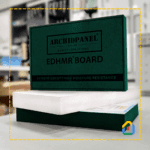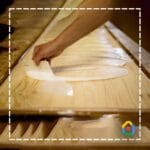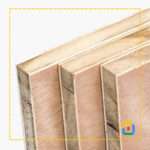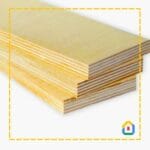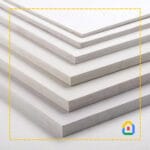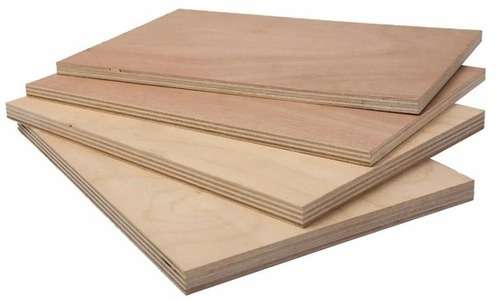Plywood is the unsung hero of the construction and interior design industry, and when it comes to India, Commercial Plywood reigns supreme. This versatile material is the backbone of many projects, offering durability, affordability, and flexibility for a wide range of applications. In this comprehensive guide, we will delve deep into Commercial Plywood in India, exploring its characteristics, applications, grades, and much more.
Understanding Commercial Plywood
What is Commercial Plywood?
Commercial Plywood is a type of engineered wood product made from thin layers of wood veneer, known as plies or layers, glued together using strong adhesive. These plies are usually oriented with their grain perpendicular to adjacent layers to enhance the strength and stability of the finished plywood sheet. The result is a composite material that combines the natural beauty of wood with remarkable structural integrity.
Composition:
Commercial Plywood typically consists of three or more layers, with an odd number of plies to maintain balance. The inner layers, known as the core, are often made from lesser-quality wood, such as poplar or hardwood, while the outer layers, called the face and back veneers, are crafted from high-quality wood species like birch, teak, or oak. The face veneer is the visible, smooth surface, while the back veneer may have a rougher appearance.
Manufacturing Process:
The manufacturing process of Commercial Plywood involves several key steps:
- Peeling: Logs are rotary-cut or peeled into thin sheets, creating veneers that serve as the core and outer layers of the plywood.
- Drying: The veneers are dried to reduce moisture content and ensure stability.
- Gluing: Adhesive, usually phenol-formaldehyde or urea-formaldehyde resin, is applied to the veneers. The veneers are then stacked with their grains perpendicular to one another.
- Pressing: The veneer stack is placed in a hydraulic press, where it is subjected to high pressure and temperature. This process bonds the layers together and activates the adhesive, creating a solid, stable sheet of plywood.
- Cutting and Finishing: The finished plywood sheets are cut to size, sanded to achieve a smooth surface, and trimmed to remove any defects.
Grades of Commercial Plywood
Commercial Plywood comes in various grades, which indicate the quality and intended use of the plywood. The Bureau of Indian Standards (BIS) has established a grading system for plywood in India, which includes the following commonly used grades:
1. MR Grade (Moisture Resistant Plywood)
MR Grade plywood is suitable for interior applications where it may be exposed to occasional moisture but not prolonged water exposure. It is often used for furniture, cabinets, and interior paneling. MR plywood should not be used in areas with high humidity or continuous water contact.
2. BWR Grade (Boiling Water Resistant Plywood)
BWR Grade plywood is designed to withstand prolonged exposure to water and moisture. It is bonded with a waterproof adhesive that can endure boiling water without delaminating. BWR plywood is ideal for outdoor applications, such as making doors, window frames, and exterior furniture.
3. BWP Grade (Boiling Water Proof Plywood)
BWP Grade plywood is the highest quality when it comes to water resistance. It can endure not only boiling water but also extreme weather conditions. BWP plywood is commonly used for marine applications, such as boat building, as well as outdoor structures where water resistance is paramount.
4. Commercial Grade
Commercial Grade plywood is the most basic and affordable option. It is suitable for non-structural interior applications where appearance is not a primary concern. This grade may have minor surface imperfections, making it a cost-effective choice for temporary structures, packaging, and similar uses.
5. Decorative Plywood
Decorative Plywood is distinguished by its high-quality face veneers, which are often made from premium wood species like teak, oak, or walnut. This plywood is used when aesthetics are crucial, such as for high-end furniture, wall paneling, and cabinetry.
Advantages of Commercial Plywood
Commercial Plywood offers numerous advantages that contribute to its widespread use in India’s construction and interior design sectors:
1. Strength and Durability:
Plywood’s layered structure gives it exceptional strength and resistance to bending and warping. It can support heavy loads, making it suitable for various structural and non-structural applications.
2. Versatility
Commercial Plywood is highly versatile and can be used in a wide range of applications, including furniture, cabinets, partitions, flooring, roofing, and more.
3. Cost-Effective
Compared to solid wood, plywood is more affordable, making it an excellent choice for budget-conscious projects without compromising on quality.
4. Resistance to Cracking
Plywood is less prone to cracking than solid wood, making it a dependable choice for applications where stability is crucial.
5. Easy Workability
Plywood can be easily cut, drilled, and shaped to meet specific project requirements, allowing for creative and customized designs.
6. Wide Availability
Commercial Plywood is readily available in various thicknesses, sizes, and grades, making it convenient for builders, carpenters, and designers.
7. Sustainability
Many plywood manufacturers in India adhere to sustainable forestry practices, ensuring a renewable and eco-friendly source of wood.
Applications of Commercial Plywood
Commercial Plywood finds its way into numerous applications across residential, commercial, and industrial settings. Some of its primary uses include:
1. Furniture
Plywood is a popular choice for crafting furniture, including tables, chairs, cabinets, wardrobes, and beds. Its strength and versatility allow for the creation of durable and aesthetically pleasing pieces.
2. Cabinetry
Kitchen and bathroom cabinets are often constructed using plywood due to its ability to withstand moisture and provide a stable base for countertops and storage.
3. Interior Paneling
Plywood is used for interior wall paneling, adding texture and warmth to interior spaces. It can also serve as a base for decorative finishes like veneers and laminates.
4. Flooring
Plywood subflooring provides a stable foundation for various types of flooring materials, including hardwood, laminate, and vinyl.
5. Roofing
In roofing applications, plywood is used as roof decking to create a sturdy base for shingles or other roofing materials.
6. Doors and Windows
Plywood is often used to manufacture doors, window frames, and shutters, especially in BWR and BWP grades for outdoor durability.
7. Partitions and Ceilings
Plywood partitions and ceilings are common in both residential and commercial spaces, offering a cost-effective way to divide rooms and create design elements.
8. Packaging
Commercial plywood is used in the packaging industry for creating crates, boxes, and pallets due to its strength and ease of customization.
Maintenance and Care
To ensure the longevity and performance of Commercial Plywood, proper maintenance and care are essential:
- Protection from Moisture: Avoid prolonged exposure to moisture, especially for MR Grade plywood. Use appropriate sealants and finishes to protect exposed edges and surfaces.
- Regular Cleaning: Clean plywood surfaces regularly with a damp, not wet, cloth to remove dust and dirt. Avoid

